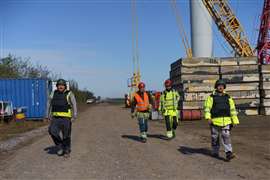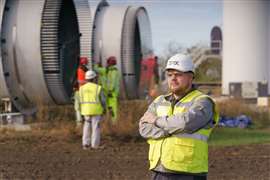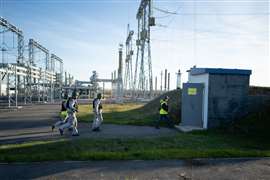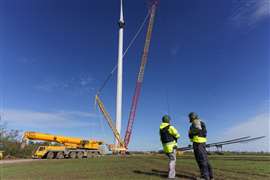Construction under fire: Building a wind farm in a major conflict zone
25 August 2023
Tyligulska Wind Power Plant, located to the west of Kherson, is the world’s only windfarm to be built in a major conflict zone. Lucy Barnard speaks to some of the construction workers braving Russian missile attacks to build it.
Silhouetted against picture perfect blue skies in the Mykloaiv region, nineteen recently erected wind turbines are slowly turning in the dusty winds which billow across the Ukranian Steppe.
Unlikely as it may seem, these 125-metre-tall Vestas EnVentus 6.0 turbines were completed only three months ago – and in some of the most extreme conditions construction teams could imagine.
Originally planned by Ukrainian energy giant DTEK before the war in 2020 and only partially completed at the time of the invasion, Tyligulska Wind Power Plant, located to the west of Kherson, is the world’s only windfarm to be built in a major conflict zone.
 Tyligulska site manager, Yevhen Moroz (left) and co-workers wear bullet proof vests and kevlar helmets on site. Photo: DTEK
Tyligulska site manager, Yevhen Moroz (left) and co-workers wear bullet proof vests and kevlar helmets on site. Photo: DTEK
“The turbine construction technology was planned for standard, non-military conditions, when the bad weather could be the only obstacle,” says Tyligulska site manager, Yevhen Moroz. “The process requires maximum concentration, maximum attention. Imagine, you are tuned in to working - and then an air raid alarm sounds. Sometimes we were sitting in shelters for six hours. Then you get back to work and check everything again. You climb 125 meters up and – again hear the air raid alarm!”
DTEK, the largest commercial energy company in Ukraine, broke ground on the project in late 2021, having acquired the 19 turbines from Danish turbine manufacturer Vestas and signed an installation agreement with Danish turbine installation company FairWind.
At first, work progressed smoothly enough with all site roads completed, a few hardstands finished, and six turbines erected.
Yet by February 2022, with news of Russian troops massing on the border and world leaders engaged in last minute tasks to avert a crisis, Western embassies advised their nationals to leave the country as soon as possible. The Vestas and Fairwind contractors took the decision to leave the country, taking their cranes and other equipment with them.
Russian invasion halts construction
On 24 February 2022, Russia invaded Ukraine, attacking the nearby city of Mykolaiv and occupying a swathe of land directly to the east of the city.
“The war caught our team of the Tyligulska wind farm at four o’clock in the morning,” says Oleg Solovei, director of DTEK Tyligulska WPP. “All of us woke up to a the sound of continuous heavy gunfire. Our first step in that situation was to evacuate our employees and to secure their safety.”
 Tyligulska site manager, Yevhen Moroz. Photo: DTEK
Tyligulska site manager, Yevhen Moroz. Photo: DTEK
However, just a few months after the first Russian attacks, it soon became clear that the invasion was faltering and turning into a long and grinding war of attrition. With Russian forces in control of Ukraine’s largest nuclear power plant as well as 90% of its renewable energy plants, the need for new power sources was becoming acute.
“In April and May, our colleagues began to return to the construction site and began to preserve the equipment in order to save the facility so that it could be completed and put into operation in the future,” says Liudmyla Yefremova, manager of technical supervision and commissioning of DTEK Construction solutions.
Nonetheless, with overseas contractors still advised against returning to the site which remained a war zone, the team was faced with the very real difficulties of attempting to complete construction without any of the heavy equipment it needed or any of the supervisors who had been overseeing operations.
Despite a nationwide lack of heavy equipment, heavy lifting partner, the Crane Ukraine Company succeeded in locating just one Liebherr LR1600 wheeled lattice boom crane capable of lifting the huge turbines into place. However, this needed to be upgraded with specialist equipment for turbines – gear which was eventually supplied by Danish company BMS Heavy Cranes.
Erecting turbines in a war zone
The team also contacted manufacturer Vestas to find out if they could offer any advice for erecting turbines in a war zone. Together with Vestas’s security officer, it developed a plan for construction that included monitoring the front line fighting to ensure that enemy forces remained no closer than 50 kilometers away. Specialists from FairWind also agreed to return to the site, despite the very real risks, to help oversee the work.
Eventually, construction work re-started on site in October 2022 just as Ukrainian troops started to regain control of Kherson and the Russian forces retreated to the east of the Dnipro River.
Even once they had found the right equipment and devised a plan to install the turbines, the team also faced the added difficulties of lifting complex and heavy loads in open fields during Russian missile bombardments just 60 miles from the front lines.
 The construction team runs to the bomb shelter during a Russian air raid. Photo: DTEK
The construction team runs to the bomb shelter during a Russian air raid. Photo: DTEK
Staff had to work wearing bullet proof vests, kevlar helmets and be ready to stop work at a moment’s notice in order to evacuate if the air raid siren sounded.
Although Tyligulska never suffered a direct hit during construction, the team reports that a total of 296 air raid alerts sounded, each one necessitating crews to stop work, lower any loads to the ground safely and run to the shelters. In total the team calculates that staff spent more than 300 hours in bomb shelters.
Moroz points out that, faced with both the Ukrainian winter and the Russian missile attacks, finding a suitable time slot to undertake lifts proved to be no easy task. One turbine remained mounted ready for lifting for 24 days in January 2023.
Yet with pressure mounting from the Ukrainian authorities to get the wind farm up and running as quickly as possible, the construction crews had to find other ways to speed up delivery.
In February the team received special permission from the regional military authorities to work at nights and bought special lighting equipment to illuminate the site, enabling the team to return to its pre-wartime speed of assembling each turbine in six days.
Speeding up delivery
In May 2023, DTEK officially opened Tyligulska Wind Power Plant Phase I – just one year later than originally planned - with an installed capacity of 114 MW.
And, in a war in which Russia has attempted to pound its opposition into submission by seizing a large part of the country’s power stations and cutting off the supply of natural gas which fuelled some of them, the Ukranians say Tyligulska provides a key strategic – and symbolic - advantage.
Antonina Antosha, DTEK spokeswoman says that the Tyligulska turbines are currently able to produce enough electricity to power around 220,000 households a year.
 The Liebherr LR 1600 crawler crane in operation at the Tyligulska Wind Power Plant site. Photo: DTEK
The Liebherr LR 1600 crawler crane in operation at the Tyligulska Wind Power Plant site. Photo: DTEK
Moreover, she adds, while one well-placed drone can destroy an entire power plant, the fact that turbines are located hundreds of feet away from each other means that it would take dozens of missiles to destroy a wind farm.
“Even if one turbine is hit, the others keep running and generating electricity,” Antosha says. “Whereas when a transformer is hit, the whole [thermal power] plant goes out of operation for an unpredictable period of time.”
And, with the need for secure power sources continuing to play a leading role in the war, Ukraine is hoping to expand Tyligulska further.
DTEK, which is owned by Ukraine’s richest man, oligarch Rinat Akhmetov, has already announced plans to install a further 64 turbines at the Tyligulska site – something which, if successful, would make it Eastern Europe’s largest wind plant.
“We call it the “green counteroffensive,” says Antosha. “Obviously the Russians will start destroying Ukraine’s energy system again as winter approaches. Instead of repairing the destroyed facilities over and over again, we decided to build new ones - clean and green.”
STAY CONNECTED



Receive the information you need when you need it through our world-leading magazines, newsletters and daily briefings.
CONNECT WITH THE TEAM








